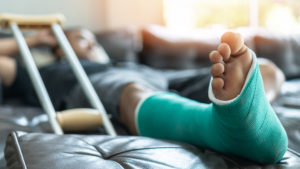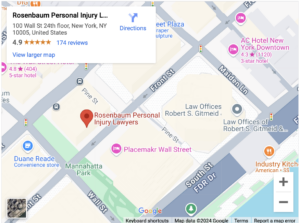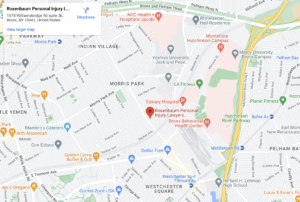Broken Bones

An accident can fracture bones into one or more pieces. Fractured bones produce a lot of pain. They can also make your body feel unstable as your broken bones cannot support their normal loads.
Broken bones can also cause permanent disabilities. The jagged edge of a broken bone can damage soft tissue like nerves and blood vessels. Over the long run, a broken bone can produce arthritis in nearby joints.
Here is some information about broken bones and the compensation you can seek for them.
Table of Contents
How Do Broken Bones Happen?
Broken bones happen in two primary different ways:
Force
A force fractures a bone when it overcomes its structural strength and causes it to break.
The force can impact the bone directly. For example, the impact of an airbag on your face during a car accident can break your cheekbone.
The force can also cause bones to collide with each other. The collision can fracture the bones even though they did not get hit by an outside object. In a slip and fall accident, you could fracture your wrist trying to catch yourself.
Even though your wrist did not hit the ground, the force of your hand hitting the ground can fracture bones in your wrist.
The force does not need to come from an impact or collision. Crushing forces can also fracture or shatter bones. A machine with a faulty safety sensor could crush the bones in your hand in a workplace accident.
Repetitive Stress
Fractures can also result from smaller forces. These forces do not break the bones but only crack them. Over time, repetitive motions cause the cracks to propagate into stress fractures.
Stress fractures often happen in the workplace. Repetitive motions like typing, lifting, carrying, walking, and standing can result in stress fractures.
What Are the Different Types of Fractures?
Fractures can happen in a variety of ways, including:
Transverse Fractures
A transverse fracture crosses laterally across the bone. The bone fractures into two pieces, neither of which pierces the skin.
In a non-displaced fracture, the ends of the bone remain aligned. Doctors can usually immobilize the bone with a cast for four to six weeks until the bone heals.
In a displaced fracture, the ends of the bone shift out of alignment. Doctors may set the bone by moving it back into place without surgery. In severe cases, doctors may need to operate to move the bone pieces into alignment and pin them in place with plates and screws.
Compound Fractures
In a compound fracture, the ends of the bone pieces displace so far that they puncture the skin, leaving an open wound. Doctors almost always operate to realign the bone pieces and pin them together.
Doctors also need to clean the wound to minimize the risk of infection.
Comminuted Fractures
A comminuted fracture happens when the bone shatters into three or more pieces. Doctors attempt to reconstruct the bone using plates and screws. If doctors cannot find some of the pieces, they may use a bone graft from the patient or a cadaver.
In extreme situations, the bone may shatter into too many pieces to reconstruct. The surrounding tissue might sustain too much damage to survive. In either of these cases, doctors may recommend amputation, rather than trying to save the part.
Avulsion Fractures
This type of fracture can result from trauma or repetitive stress. Tendons and ligaments attach to bones. An avulsion fracture happens when a ligament or tendon breaks the bone at its attachment. As a result, the ligament or tendon breaks loose with a small piece of broken bone attached to it.
If the bone does not displace, doctors can immobilize the break and allow it to heal. If the piece of bone displaces, doctors might need to operate to reconstruct the bone before immobilization.
What Complications Can Arise from Bone Fractures?
Bone fractures can lead to other health problems, such as:
Blood Clots
When a bone is fractured, the body forms a blood clot at the site of the break. This blood clot kicks off the healing process.
If the blood clot breaks off, it can travel through the bloodstream. If it reaches the heart or the major blood vessels of the heart, the blood clot can cause a heart attack.
If the blood clot reaches the brain or the blood vessels feeding the brain, it can cause a stroke.
If the blood clot reaches the lungs, it can cause a pulmonary embolism.
All of these conditions can increase the risk of death.
Compartment Syndrome
Compartment syndrome happens when tissue swells and cuts off the body’s blood supply. The body parts downstream from the swelling can quickly become deprived of oxygen and nutrients. The oxygen-deprived tissue can die if doctors cannot relieve the constriction quickly enough.
Soft Tissue Damage
When a person has a displaced fracture, the bone pieces move out of alignment. When the bone moves, the jagged edge can tear muscle, tendons, ligaments, nerves, and blood vessels.
Muscles, tendons, and ligaments can heal. However, torn nerves and blood vessels might not heal. Torn nerves can cause numbness and deprive you of motion or dexterity in the area. Torn blood vessels can leave the area undernourished and cause tissue to atrophy or die.
What Compensation Can I Seek for Broken Bones?
Broken bones can entitle you to substantial compensation. Your compensation depends on your present and future medical expenses and lost income.
If your fractured bone requires surgery, you could face huge medical expenses. You could also lose income during the four to six weeks that you need to wear a cast.
You might even experience permanent disability after a fracture. Minor fractures can change the load on your joints, sometimes leading to arthritis. A fracture in a neck or back vertebrae can cause a spinal cord injury or even lead to permanent paralysis.
Significantly, New York’s no-fault auto insurance system releases you from its restriction on lawsuits if you suffer a fracture in a car accident. This means you can file a lawsuit and pursue damages for pain and suffering on top of your economic losses.
However, it’s important to file a claim in a timely manner, as time limits may apply to your case.
Contact a New York City Personal Injury Lawyer for Help
If you’ve been injured in an accident, reach out to the skilled attorneys at Rosenbaum Personal Injury Lawyers. We’ll talk through the circumstances that led to your broken bones and help you to explore your legal options.
To discuss the compensation you can seek for your broken bones, contact our New York City personal injury lawyers for a free consultation at (212) 514-5007.



